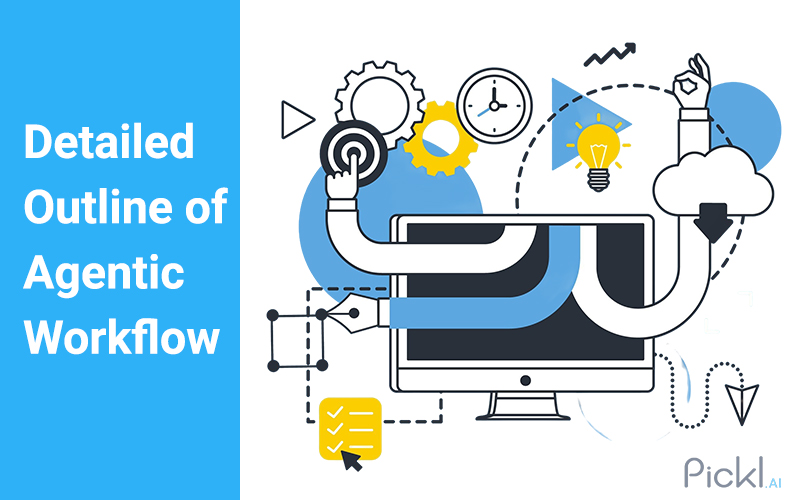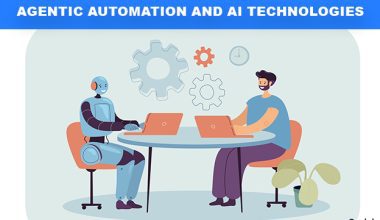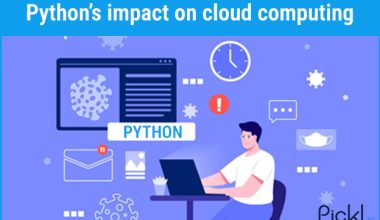Summary: Agentic workflows are smart systems where autonomous AI agents plan and execute complex tasks to achieve a goal. Unlike single AI agents, they coordinate entire processes, boosting productivity and efficiency. This guide covers their definition, key benefits for business, and provides real-world examples in marketing, research, and software development.
Introduction
We are drowning in complex tasks. This overwhelming reality requires a new way of working, where technology doesn’t just follow commands but actively helps us achieve our goals. For years, AI has been a tool we direct, but the next evolution is here, transforming AI into a proactive teammate through the power of agentic workflows.
This guide will explain the definition of agentic workflows, provide clear examples, outline their powerful benefits, and show you how they are reshaping the future of business and productivity.
Key Takeaways
- Agentic workflows are autonomous AI systems that plan and execute complex goals.
- They dramatically boost productivity by automating end-to-end complex business processes.
- A workflow coordinates multiple specialized AI agents to work together as a team.
- These systems can adapt, reason, and self-correct when facing unexpected problems.
- The future is humans and AI collaborating seamlessly within these advanced workflows.
What Are Agentic Workflows?
Agentic workflows are smart systems. They are advanced, multi-step processes managed by autonomous AI agents that can reason, plan, and execute tasks to reach a specific objective without step-by-step human guidance.
Think of it less like giving a calculator a sum to solve and more like asking a project manager to launch a new product. You provide the final goal, and the agentic workflows design and execute the necessary steps, adapting to challenges along the way.
This brings up a key distinction in the discussion of agentic workflows vs AI agents. An AI agent is a single entity capable of performing tasks, like a research analyst or a copywriter.
An agentic workflow, however, is the entire strategic process or framework that coordinates one or more of these agents to work together towards a complex goal, ensuring they collaborate, pass information, and self-correct to achieve the desired outcome.
Key Features of Agentic Workflows

The power of these systems comes from a few core characteristics. Agentic workflows are defined by their unique capabilities that set them apart from traditional automation.
Autonomy
They operate independently. Once a goal is set, these workflows can proceed without constant human intervention, making decisions and taking actions on their own.
Goal-Orientation
You define the “what,” not the “how.” Instead of providing a rigid list of commands, you give the workflow a high-level objective, and it determines the best path to get there.
Adaptability and Reasoning
The world is full of surprises. Agentic workflows are designed to handle unexpected issues, changing their plans and finding alternative solutions when they hit a roadblock.
Collaboration
They foster teamwork among AI. Many advanced agentic workflows involve multiple specialized AI agents that can collaborate, delegate tasks, and share information to solve a problem more efficiently.
Benefits of Agentic Workflows for Businesses
Adopting these advanced systems is a game-changer. Businesses that implement agentic workflows unlock a new level of operational excellence and strategic advantage.
Massive Productivity Boost
They automate complex, end-to-end processes. This frees up human teams from tedious, time-consuming tasks, allowing them to focus on high-value strategic work that requires creativity and critical thinking.
Enhanced Efficiency and Speed
Complex projects are completed faster. By breaking down goals and executing steps 24/7, agentic workflows dramatically reduce project timelines from weeks to days, or even hours.
Improved Accuracy and Consistency
Human error is significantly reduced. For processes requiring meticulous attention to detail, agentic workflows ensure that tasks are performed consistently and accurately every single time.
Unprecedented Scalability
Your operational capacity can grow without limits. Agentic workflows allow you to handle a massive volume of complex tasks simultaneously without needing to proportionally increase your headcount.
Real-World Use Cases: Agentic Workflows Examples

The theory is powerful, but the applications are revolutionary. Here are a few practical agentic workflows examples that show how this technology is being used today.
Automated Market Research and Reporting
Goal: “Create a comprehensive report on the top 5 competitors for our new software product.”
Workflow: A “Research Agent” scours the web for competitor websites, reviews, and news. A “Data Analysis Agent” synthesizes this information to identify strengths and weaknesses. Finally, a “Report Writing Agent” compiles the findings into a structured, easy-to-read document.
Autonomous Software Development and Debugging
Goal: “Find and fix critical bugs in the user authentication module of our app.”
Workflow: A “Code Scanning Agent” identifies potential bugs in the codebase. An “Analysis Agent” determines the root cause of the bug and proposes a fix. A “Testing Agent” then implements the fix in a test environment and verifies that the bug is resolved before notifying a human developer for final approval.
End-to-End Content Marketing Campaigns
Goal: “Launch a social media campaign to promote our upcoming webinar.”
Workflow: A “Strategy Agent” researches the target audience and suggests key themes. A “Content Creation Agent” writes blog posts, social media captions, and email copy. A “Scheduling Agent” then pushes this content to various platforms at optimal times.
How to Implement Agentic Workflows in Your Organization
Getting started doesn’t have to be overwhelming. You can begin implementing agentic workflows with a measured and strategic approach.
Step 1: Identify the Right Process
Start by targeting a high-value, repetitive, and rule-based but complex process that currently consumes significant human hours.
Step 2: Define Crystal-Clear Goals
The success of agentic workflows depends on the clarity of the objective. Be extremely specific about what “done” looks like.
Step 3: Leverage the Right Platforms
Utilize frameworks like Microsoft AutoGen, LangChain, or other specialized AI platforms that provide the tools to build and connect AI agents.
Step 4: Start Small and Iterate
Implement a pilot project with a human-in-the-loop for oversight. Monitor its performance, gather feedback, and gradually refine the workflow to improve its autonomy and reliability.
Challenges & Risks
This technology is not without its challenges. Implementing agentic workflows requires careful consideration of potential risks and complexities.
Setup Complexity
Designing and configuring a robust workflow can be technically demanding.
Lack of Control
Fully autonomous systems can sometimes produce unexpected or incorrect results (“hallucinations”), requiring strong oversight and validation mechanisms.
Security Concerns
Granting AI agents access to sensitive company data and systems creates potential security vulnerabilities that must manage carefully.
High Computational Cost
Running complex, multi-agent systems can be resource-intensive and expensive.
The Future of Agentic Workflows
The future is incredibly bright. We are moving towards a world where agentic workflows are not just a tool for specialists but an integrated part of everyday business operations.
Expect to see hyper-personalized customer service journeys managed entirely by AI, fully autonomous business units that handle everything from supply chain to marketing. The continued development of these powerful agentic workflows will define the next decade of innovation.
Conclusion
Agentic workflows represent a fundamental paradigm shift in our relationship with technology. We are moving away from being simple taskmasters and becoming strategic collaborators with intelligent, autonomous systems.
By understanding the core definition of agentic workflows, their key features, and their transformative benefits, businesses can begin to unlock unprecedented levels of productivity and innovation. The journey has just begun, and the organizations that embrace the power of agentic workflows today will be the leaders of tomorrow.
Frequently Asked Questions
What is the difference between agentic and non-agentic workflows?
A non-agentic workflow is a fixed, linear sequence of predefined tasks, much like a traditional assembly line. It cannot deviate from its script. In contrast, an agentic workflow is dynamic and intelligent; it can reason, make decisions, and adapt its plan to achieve a goal, even when faced with unexpected obstacles.
What is the difference between RPA and agentic workflow?
Robotic Process Automation (RPA) is designed to automate simple, repetitive, rule-based tasks within structured environments, like copying data from a spreadsheet to a form. An agentic workflow handles much more complex, unstructured problems that require planning, reasoning, and multi-step execution, similar to the tasks a human knowledge worker would perform.
What is the difference between RAG and agentic workflow?
Retrieval-Augmented Generation (RAG) is a technique use by an AI model to improve its accuracy by fetching external, up-to-date information before generating a response. An agentic workflow is the entire strategic process or framework. An AI agent within an agentic workflow might use the RAG technique as one of its tools to complete a step in its broader mission to achieve a complex goal.



